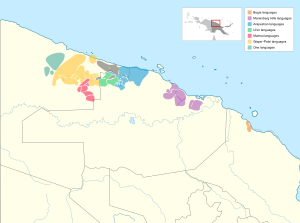| Urim | |
|---|---|
| Kombio | |
| Geographic distribution | East Sepik Province, Papua New Guinea |
| Linguistic classification | Torricelli
|
| Subdivisions | |
| Glottolog | mari1433 |
 The Torricelli languages as classified by Foley (2018) | |
The Urim languages constitute a branch of the Torricelli language family. They are spoken in East Sepik Province, in areas bordering the northeastern corner of Sandaun Province.
Languages
[edit]Foley (2018) lists the following languages.[1]
Vocabulary comparison
[edit]The following basic vocabulary words are from Laycock (1968),[2] as cited in the Trans-New Guinea database:[3]
The words cited constitute translation equivalents, whether they are cognate (e.g. neːp, nihip for “leg”) or not (e.g. ləŋkəp, ntoh, emen for “head”).
gloss Urim Urat Torricelli head ləŋkəp ntoh emen ear nurkul kwin wolep eye iːkŋ ampep yempit nose ləmp muhroŋ wujipen tooth eːk asep nal tongue milip yaŋklou leg neːp nihip araiʔ louse nəmin ompik numuk dog nəmpa pwat yimpeu bird wel antet elip egg haləmpar yimpwonən blood waləmpop wim yalkup bone təpmuŋkut lupuŋ ləp skin palək yahreik alou breast maː ampreip yimep tree yoː lou lu man kəmel mik eiŋ woman kiːn tuwei injik sun takəni nai awən moon kanyil wantihi iyén water huw pənip wop fire waːkŋ nih yotou stone weit yah əntoʔ two weːk hoi wiyeu
References
[edit]- ^ Foley, William A. (2018). "The Languages of the Sepik-Ramu Basin and Environs". In Palmer, Bill (ed.). The Languages and Linguistics of the New Guinea Area: A Comprehensive Guide. The World of Linguistics. Vol. 4. Berlin: De Gruyter Mouton. pp. 197–432. ISBN 978-3-11-028642-7.
- ^ Laycock, Donald C. 1968. Languages of the Lumi Subdistrict (West Sepik District), New Guinea. Oceanic Linguistics, 7 (1): 36-66.
- ^ Greenhill, Simon (2016). "TransNewGuinea.org - database of the languages of New Guinea". Retrieved 2020-11-05.
- Foley, William A. (2018). "The Languages of the Sepik-Ramu Basin and Environs". In Palmer, Bill (ed.). The Languages and Linguistics of the New Guinea Area: A Comprehensive Guide. The World of Linguistics. Vol. 4. Berlin: De Gruyter Mouton. pp. 197–432. ISBN 978-3-11-028642-7.
Well, that’s interesting to know that Psilotum nudum are known as whisk ferns. Psilotum nudum is the commoner species of the two. While the P. flaccidum is a rare species and is found in the tropical islands. Both the species are usually epiphytic in habit and grow upon tree ferns. These species may also be terrestrial and grow in humus or in the crevices of the rocks.
View the detailed Guide of Psilotum nudum: Detailed Study Of Psilotum Nudum (Whisk Fern), Classification, Anatomy, Reproduction